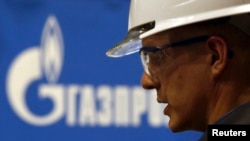MOSCOW —
Russia's top natural gas producer Gazprom said it would be able to meet Europe's rising demand for gas thanks to new projects, even while the European Union is aiming to reduce its energy dependence on Moscow.
“According to most of the scenarios, which have been reviewed, long-term gas demand will increase in the European market, a key one for Gazprom, against the background of its [Europe's] own production decline,” Gazprom said in a statement on Tuesday after its board meeting.
Supplies to Europe can be increased via the Nord Stream undersea pipeline as well as through the proposed South Stream link, which is expected to start operating next year, the company specified.
Gazprom also plans to build a gas liquefaction plant on the shores of the Baltic Sea, which could then export liquefied natural gas (LNG) to European markets.
Partly as a result of the Ukraine crisis, meanwhile, Europe is stitching together a patchwork of measures such as raising power output from coal and renewables to reduce its gas imports from Russia by the end of the decade, easing Moscow's grip over the region's energy market.
Reuters calculations suggest that these steps could slash imports from Russia by around 45 billion cubic meters (bcm) by 2020, worth $18 billion a year, or the equivalent of a quarter of what Russia currently supplies.
So far, however, Gazprom's gas supplies and its share of the European market have been increasing as flows have declined from other sources such as North Africa and LNG suppliers have sent more cargoes to Asia, where gas prices are higher, instead of Europe.
Gazprom's share in Europe's gas market rose to 30 percent in last year from around 25 percent in 2010. Its supplies to the European Union and Turkey jumped to 162 billion cubic meters.
The Kremlin-controlled company also said on Tuesday it expected to boost its exposure to the Asia Pacific region. The company aims to reach a deal in May to supply gas to China after a decade-long talks.
“According to most of the scenarios, which have been reviewed, long-term gas demand will increase in the European market, a key one for Gazprom, against the background of its [Europe's] own production decline,” Gazprom said in a statement on Tuesday after its board meeting.
Supplies to Europe can be increased via the Nord Stream undersea pipeline as well as through the proposed South Stream link, which is expected to start operating next year, the company specified.
Gazprom also plans to build a gas liquefaction plant on the shores of the Baltic Sea, which could then export liquefied natural gas (LNG) to European markets.
Partly as a result of the Ukraine crisis, meanwhile, Europe is stitching together a patchwork of measures such as raising power output from coal and renewables to reduce its gas imports from Russia by the end of the decade, easing Moscow's grip over the region's energy market.
Reuters calculations suggest that these steps could slash imports from Russia by around 45 billion cubic meters (bcm) by 2020, worth $18 billion a year, or the equivalent of a quarter of what Russia currently supplies.
So far, however, Gazprom's gas supplies and its share of the European market have been increasing as flows have declined from other sources such as North Africa and LNG suppliers have sent more cargoes to Asia, where gas prices are higher, instead of Europe.
Gazprom's share in Europe's gas market rose to 30 percent in last year from around 25 percent in 2010. Its supplies to the European Union and Turkey jumped to 162 billion cubic meters.
The Kremlin-controlled company also said on Tuesday it expected to boost its exposure to the Asia Pacific region. The company aims to reach a deal in May to supply gas to China after a decade-long talks.









